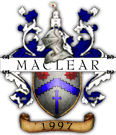It all began with some sheep.
The Kilt and the Black Watch
The kilt, or philabeg to use its older Gaelic name, that has now become the standard dress for all "Highlanders", has its origin in an older garment called the belted plaid. The Gaelic word for tartan is breacan, meaning "partially colored or speckled", and every tartan today features a multicolored arrangement of stripes and checks. These patterns, or sett's, are used to identify the clan, family, or regiment with which the wearer is associated.
The first recognisable effort to enforce uniformity throughout an entire clan was in 1618, when Sir Robert Gordon of Gordonstoun, wrote to Murry of Pulrossie requesting that he bring the plaids worn by his men into "harmony with that of his other septs."
After 1688, and the fall of the Stuart clan, and subsequent rise in the spread of Jacobism, the English government felt the need to take a more active interest in the Highland affairs. In 1707, The Act of Union took place, and succeeded in temporarily uniting the political factions and clans that were universally opposed to the Act. The tartan came into it's own as a symbol of active nationalism and was seen by the ruling classes to be garb of extremism. It is also believed that this act of parliament succeeded in uniting, to some extent, the Scottish Highlands and Lowlands, as the wearing of the tartan spread from the Highlands to the Lowlands, previously not known for their wearing of the tartan.
After the rising of 1715, the Government found the need to enforce stricter policing of the Scottish Highlands and Lowlands. A number of independent companies were formed to curtail the lawlessness that had developed. From the time they were first raised, these independent regiments became known as the Black Watch, in reference to the darkly colored tartans they were known to wear.
One of the more famous tales of these Highland companies is told of the curiosity of King George, who had never seen a Highland soldier. Three handsome privates were chosen and dispatched to London to be presented to the King. The King was so impressed with the skill with which they wielded their broad swords and lochaber axes that he presented them each with a guinea. Nothing could be more insulting to a Highland gentleman, but they could not refuse the gift. Instead they accepted the gift, and as they left, flipped it smugly to the porter as they passed the palace gates.
In 1740, these independent companies became a formal regiment, and the need arose to adopt a formal tartan. This became a problem, for what tartan could they choose, without insulting certain clans, or seeming to favour others? In the end, an entirely new tartan was developed and has ever since been known as the Black Watch Tartan. It was the first documented tartan to be known by an official name and possesses the authenticity of a full pedigree. From this tartan has been derived all of the Highland regimental tartan designs and many of the hunting setts worn by other clans.

